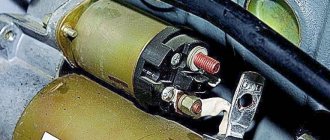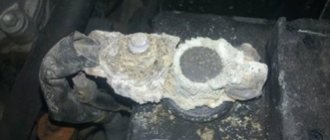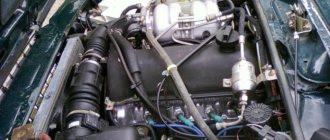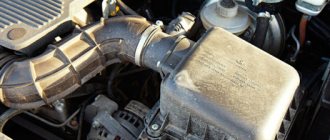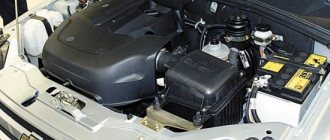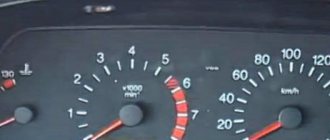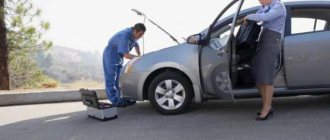It often happens that all standard units are working properly, but the engine does not start. At the same time, the error indicator on the “Check” dashboard does not light up.
It is extremely difficult to immediately name the most likely reason, since there can be at least a dozen of them. It is not advisable to try to find and fix a breakdown on your own without experience. It is better to contact a professional workshop.
Electrical reasons
First of all, you need to remove the cap from the spark plug (any one) and install spark plug A17 DVRM. Holding it with pliers, turn on the starter.
To remove the cap, hold the spark plug by the hexagon (pliers with insulated handles are suitable). It is necessary that the spark plug body touches the “ground”. As a result, you will be able to see a spark. In the case where there is no spark, this indicates:
- malfunction of the ECM or lack of voltage;
- combustion of the ignition coil module;
- damage to high-voltage wires.
By the way, a spark “in the air” does not guarantee its presence in the engine. Spark plugs can be faulty, there is a gap violation, etc.
Parts and consumables:
- Oil filter
- Engine oil
- Rags
Problems with starting a car engine can be divided into two main groups depending on the degree of engine heating.
Engine cold
From the moment the engine was turned off, at least 6 hours have passed at an outside air temperature of +20 °C and at least 3 hours at -20 °C; the oil temperature in the engine crankcase coincides with the ambient temperature. The techniques for starting an engine with a fuel injection system are the same at any outside temperature.
1. Open the hood by pulling the hood lock drive handle towards you.
2. Using an oil dipstick, measure the oil level. It should be between the “MAX” and “MIN” marks.
3. Check the brake level.
4. . and coolants.
5. Carefully inspect the engine and engine compartment. Pay attention to leaks of gasoline, oil, brake and coolant. Make sure the electrical wiring is intact. Check the fit of the high-voltage wires into the ignition module sockets and onto the spark plugs.
6. Turn on the ignition by turning the key in the ignition switch to position “I”. The electric fuel pump will turn on. Without closing the hood (close the hood in case of rain or snow), get behind the wheel. Start the engine.
USEFUL ADVICE It is better to close the hood after the engine starts running. Before doing this, it is advisable to inspect the engine again, make sure there are no leaks of fuel, oil, coolant, as well as extraneous sounds in its operation.
If the engine does not start, there are three main reasons: - the starting system does not work; — the ignition system does not work; — the power system does not work.
Engine is warm or hot
The oil temperature in the engine crankcase is higher than the ambient temperature.
To start, just turn on the starter without touching the accelerator pedal. The engine control system will independently set the fuel supply and ignition parameters necessary for starting.
USEFUL ADVICE If for some reason the spark plugs are flooded during an unsuccessful start attempt, use the cylinder “blow-through” mode. To do this, press the accelerator pedal all the way and turn on the starter. In this mode, there is no fuel supply and excess gasoline is removed from the cylinders by a stream of fresh air, while the spark plugs are dried. After purging, try starting again as usual.
If the engine does not start, there are three main reasons: - the starting system does not work; — the ignition system does not work; — the power system does not work.
Starting system malfunctions
Malfunctions in the starting system manifest themselves in abnormal operation of the starter. There are five main starter malfunctions:
1. The starter does not turn on. The reason is a violation of contact connections, a break or short circuit in the starter switching circuits, a malfunction of the traction relay.
2. When the starter is turned on, multiple clicks are heard. The reason is a malfunction of the holding winding of the traction relay, the battery is severely discharged, and the contact connections in the starter circuit are loose.
3. The starter turns on, but its armature either does not rotate or rotates slowly. The reason is a discharged battery, broken contact connections, burnt contacts of the traction relay, dirty commutator or worn brushes, interturn or short circuit in the windings.
4. The starter turns on, its armature rotates, but the flywheel remains motionless. The reason is a weakening of the starter's attachment to the clutch housing, damage to the teeth of the flywheel or drive gear, slipping of the freewheel of the drive, breakage of the lever, drive ring or buffer spring of the starter drive.
5. The starter does not turn off after starting the engine. The reason is a malfunction of the starter freewheel, sintering of the contacts of the traction relay. In the event of such a malfunction, stop the engine immediately!
These faults require qualified intervention at a car service center or upon arrival at the garage. Beforehand, you can only check the degree of discharge of the battery using a voltmeter in the instrument cluster and the tightness of the contact connections in the starter circuit.
Checking the ignition system
WARNING Your vehicle is equipped with a microprocessor-based (High Energy) ignition system. A voltage of about 40,000 V is supplied to the high-voltage wires, and although at low current levels it is not life-threatening, a possible electric shock when checking the ignition system can lead to serious consequences. Therefore, if you handle a high-voltage wire with the ignition on, use a thick rubber glove or, as a last resort, pliers with insulated handles.
You will need: slotted and Phillips screwdrivers, pliers with insulated handles and a tester.
HELPFUL TIP Before checking the ignition system, place the gear shift lever in neutral and leave the parking brake on.
1. With the ignition off, check the integrity and fit of the high-voltage wires in the ignition module.
2. Disconnect the wiring harness connector from the ignition module low voltage circuit block.
3. . and check with a tester turned on in the mode of measuring low currents (tA) the low-voltage circuit of the module for an open circuit by connecting the tester probes to contacts C and B of the block.
4. If the low-voltage circuit of the ignition module is normal, check for a spark at the spark plugs to check the serviceability of the high-voltage circuit of the module and high-voltage wires. Remove the high voltage wire from any spark plug. Insert a spare spark plug into the end of the wire and press its metal part against the ground of the car. Use the starter to turn the engine crankshaft.
5. If there is no spark, replace the high-voltage wires with new ones. You can first try to install not new ones, but proven ones, “from a working machine.”
6. If a spark does not appear after replacing the wires, replace the ignition module. If there is a spark, but the engine does not start, replace the spark plugs with new ones. You can also first try to install not new ones, but proven ones, “from a working machine.”
7. If after this the engine does not start, check the serviceability of the engine control system.
The immobilizer blocks engine operation
When the immobilizer is activated, one way or another, it will block the engine from starting. This happens when, with the ignition on, the indicator starts flashing for 15 seconds and then goes out. Next, the system sends sound signals.
It’s time to disable the module on the Chevrolet Niva APS-4. Here you will need a training key (red), but APS-6 cannot be turned off. Basically, the ECM is forced to flash. There is no need to panic: the blocking is probably due to a broken reader in the cable.
A little about the fuel rail
There is a control fitting 3 on the ramp with regulator 5. The latter is hidden by a cap; you need to unscrew it and carefully press the spool. Fuel poured out - therefore, it entered the ramp. However, it is possible that the required pressure is not generated. The reasons may be clogged filter cylinder, damage to the pump, etc.
The pressure must show 350 kPa, that is, 3.5 bar. To control it, unscrew the spool and then install a pressure gauge. On the eve of the test, you should reduce your blood pressure. If there is no fuel supply, you need to pay attention to whether the pump turns on or not when turning the key to the “I” mark. When cold, the pump should operate for 10 seconds with the engine running.
Note: What happens when there is water in gasoline? In the summer - nothing. But in winter, the food system sometimes becomes clogged with ice.
Prevention of injector breakdowns
Why the injection engine does not start and how to eliminate possible problems is now known to all readers of our resource. However, it is better to avoid such breakdowns, so let’s pay attention to ordinary procedures that, if carried out systematically, will help minimize the risks of all malfunctions. The simplest but most effective prevention consists of the following measures:
- Firstly, refuel exclusively at proven gas stations and only with high-quality fuel. Remember that most fuel system and engine malfunctions are caused by dirty gasoline;
- Secondly, change all consumables on time and only with high-quality products. The most important thing is periodic replacement of all kinds of filters and engine oil;
- Thirdly, periodically check the main components of the machine for stability. The list of the latter, naturally, includes the injector, elements of the fuel system, ignition and engine;
- Fourthly, never neglect routine diagnostics of your car at a service station. Surprisingly, even a delay of a couple of hundred kilometers can cause serious damage, which previously could have been eliminated with very simple actions;
- And fifth, always operate your vehicle properly. That is, you do not need to overheat, overload or negatively impact your car in any other way.
Perhaps this is where the most important information on today’s issue has come to an end. We hope the material presented above was useful and provided answers to your questions. Good luck in operating and maintaining your car!
Fuel supply filter
There is always a small amount of moisture in the fuel. When this amount is increased, this is what can happen:
- the first start always goes without problems;
- After leaving the car in the parking lot, after 2-3 hours the driver will no longer be able to start the engine without repairs.
Everything mentioned should be attributed to the injection internal combustion engine. And here the fuel filter will be a candidate for failure. So, in the Chevrolet Niva it is located under the bottom in aluminum form. By the way, this is thought out on many machines.
Supply system
The main task of the fuel filter is to timely supply fuel to the combustion chambers. It is difficult to physically check the flow of fuel to the ramp without special equipment.
First, we check the flow of fuel through the filter. The presence (absence) of fuel will be visible through the transparent body. We replace the cleaning element with a new one as needed.
We check the limit switches, terminals on the contacts, injectors, and fuel pump. We clean, remove oxidation, tighten the clamps. We check the fuel pump for serviceability by turning the key in the ignition. A clicking sound is heard from the fuel pump. If there is none, then there is a malfunction in the “pump”.
You can verify the presence of fuel in the fuel rail, and also measure its pressure with a pressure gauge. Similar equipment is available in service centers and workshops.
Pumping up excess air
As you know, a Chevrolet engine sometimes does not want to spin because too much air is drawn into the intake manifold. Therefore, it is worth checking the fixation of all pipes and more.
The cause of excess air is damaged VUT. The engine on a Chevrolet Niva does not start while the starter is turning, which means you need to look for the problem in the brake system. But you can do it simpler:
- remove the vacuum supply hose (from the amplifier side);
- close the hose gap with your finger by performing a test run;
- the engine starts, which means the problem has been found.
Despite its apparent simplicity, damage to the air supply is difficult to see. It is worth checking how the hoses are seated on the fittings and making sure the clamps are tight.
Video diagnosing the causes of an uncertain cold start
Along with high efficiency and relative reliability, fuel-injected cars have one unpleasant drawback - the difficulty of repair. It happens that the injector suddenly stops starting, and it becomes difficult to do anything with it. It’s good if you have the opportunity to call a tow truck or show the car to a professional, but what should those motorists do who are left with the problem alone? Let's figure it out by examining in detail all the reasons why the injector starts poorly or refuses to start at all, as well as how to “treat” such a malfunction.
Damage to the starting system
Failure may manifest itself in improper operation of the starter device. Let us highlight 5 main malfunctions of this mechanism:
- The starter does not turn. The reason lies in a violation of the contact units, a break or short circuit in the starter circuit, or damage to the traction relay.
- When starting the starter on a Chevrolet Niva, there are repeated clicks. This indicates a malfunction of the traction relay, which is held by the winding, a discharge of the battery, or loose contact connections in the starter circuit.
- The starter starts, but the armature either does not rotate or rotates slowly. The cause may be a discharged battery, broken contact connections, burnt contacts of the traction relay, worn brushes, dirty commutator, interturn/short circuit of the windings.
- The starter turns on, the armature rotates, but the flywheel does not move. The problem may be loosening of the starter to the clutch housing, breakage of the flywheel teeth or drive gear. This would also include slipping of the freewheel of the drive and damage to the lever.
- The starter does not turn off after starting the Chevrolet Niva engine. The reason is a malfunction of the freewheel of the starter device, sintering of the contacts of the traction relay. If this damage occurs, stop the engine immediately.
Electrical problems
Poor starting may be caused by a malfunction in the electrical part of the vehicle. Most often, this is a discharged or failed battery. Also often the reason that it does not can be a malfunction of the starter. This happens due to it getting wet or reaching the end of its service life.
Oxidized battery terminals can cause poor engine starting. Therefore, they must be protected from oxidation by special means. And if this happens, then clean it.
No less often this occurs due to faulty spark plugs. They may suffer from bad gasoline, after which their normal operation will be disrupted. They may also simply reach the end of their service life.
The Chevrolet Niva engine may not start due to a blown or wet fuse. The rarest case is a failure of the immobilizer. However, this is also possible. If this happens, the car will not start.
Electrical faults
- First of all, for all types and models of cars, you should pay attention to the battery - it can be worn out or simply discharged.
- The starter has become wet or has become unusable.
- The terminals may have oxidized, resulting in poor battery contact.
- Malfunctions are often due to defects in spark plugs, which occur when using low-quality fuel. Also, the spark plugs could simply wear out, forming a large gap.
- Another reason is a blown fuse.
- Broken ignition relay.
- It is possible that the wire supplying the starter or injector has been torn off.
- The immobilizer is not working.
Troubleshooting electrical equipment
Battery
The battery rarely discharges suddenly. Often starting becomes difficult due to low starter speed. But there are also cases when the battery dies in a very short time. When you turn the ignition key, the dashboard may “come to life”, but when you try to turn on the starter, all the lights go out. This is an indicator of battery discharge. As a last resort, you can turn on the headlights and judge the condition of the battery by the brightness of the lamps. The way out is to charge the battery or replace it.
Starter
If the battery is in order, and clicks are heard when you turn the key, then they indicate a fault with the starter. If nothing happens (no reaction), then before sinning on the starter, you need to check the reliability of the connection of the supply wire to the starter solenoid relay. If the starter has become unusable, then its repair is possible, but it depends on the reasons, of which there may be several.
Battery terminals
If the terminals on the battery are loosely tightened, the contact area becomes covered with oxide.
It prevents the passage of current and, over time, completely opens the contact. A cracking noise may be heard when turning the key. The oxidized terminal should be cleaned, lubricated with graphite grease and tightened well.
Candles
The condition of the spark plugs is checked by inspecting the electrodes. If all the spark plugs have black soot and the electrodes are wet, this indicates that none of them are working. A candle has its own resource, but the probability of all of them failing at once is extremely low. The reason must be sought in the ignition module or its power supply. The car may not start if one spark plug is not working. In this case, the spark plug should be replaced .
Circuit breakers
The lack of power to the module is often due to a blown fuse. You need to get a fuse diagram and check the condition of the one that controls the ignition.
Immobilizer
The operation of the immobilizer is quite complex. If its settings are lost, you should try to start the car with a key equipped with a chip. But this rarely happens. The most likely cause is a dead key fob battery.
Finding out the cause of breakdowns
If you want your Chevrolet Niva to start, you must determine the problem. You can do this yourself or take it to a mechanic. But the second option requires serious financial investments. The best option, without significant investment of time and hard earned money, is to try to determine for yourself the reason why your car refuses to start. If you are unable to figure out the damage to your car on your own, you will have to contact a specialist.
When you turn the key, you can diagnose battery problems. If the panel, as they say, is silent, then you need to charge the battery. Recharging does not take much time, a few hours is enough. Perhaps the battery has already failed, then it needs to be replaced with a new one.
The cause of the malfunction is the starter. It can only be stated if there are no problems with the battery panel. It happens that you turn the key, the starter clicks, but does not start. Experts say that in this case the battery does not conduct the required amount of current to start the engine. To make sure there are problems with the starter, you need to measure the current and voltage with a volt and ammeter.
Sometimes problems with a car arise due to problems with the battery contacts. They can be detected by lifting the hood and visually assessing the level of oxidation. Unfortunately, car owners cannot always do this, due to the presence of rubber pads on the terminals.
If you suspect the source of the problem is the spark plugs, remove them from the cylinder and carefully inspect them. If they have black deposits on them and are wet, this indicates they are damaged. Dark brown is a normal candle color.
Glow plugs
The engine does not start in the cold - the first sign of failure of the spark plugs. When in good condition, candles heat the space from the inside. In the event of a breakdown, starting the engine is complicated by low temperatures and the formation of condensation.
We check the spark plugs with a multimeter and replace them with new ones as necessary. We also inspect the spark plug start relay. It should make a slight clicking sound.
The method described above is effective for the injector. In the case of a carburetor, the checking mechanism is as follows:
- open the hood, wait until the engine cools down to a safe temperature,
- remove the cradles one by one, unscrew the spark plugs, check them for the presence of a spark,
- install new spark plugs, replace them if defective ones are found,
- assembly in reverse order.
Why the Chevrolet Niva does not start: the starter turns, but the engine does not catch
It happens that the starter works fine, but the engine stubbornly refuses to start, although the Check lamp does not light up. In such cases, if we talk about the VAZ-2123 engine, we can immediately name 10 different reasons. All of them will be quite real, and not at all from the category of “contacts have oxidized.” In general, sometimes the Chevrolet Niva does not start, but the starter turns the shaft properly, and the reason should not be looked for there. Well, let's try to learn to recognize different reasons, that is, to distinguish one from the other.
Example in the video: the APS immobilizer blocked the engine because it was in learning mode!
Troubleshooting electrical problems
In most cases, you can determine the cause of the malfunction yourself without any problems. You need to turn the key. If after this no indicators on the instrument panel light up, then the problem is in the battery. Most likely, it is discharged or damaged. In this case, you can recharge the battery a little, which will take several hours. You can also try to “light” the battery from another car. If such actions do not lead to anything, it will be necessary to replace the battery.
If the battery is in good condition, you need to check: perhaps not, since the starter does not turn. The easiest way to do this is to use a voltmeter. To do this, you need to connect its wires to the starter terminals and look at the readings. It also happens that the battery is in good condition, but does not give the starter the required charge, which is necessary to start the engine. In this case, the starter will make clicking noises and nothing more.
It is also necessary to inspect the battery terminals. It often happens that they oxidize and contact does not occur through them. And all because the owners simply do not monitor the condition of the terminals. This is quite easy to determine; upon inspection, oxidation will be clearly visible.
If the above components are in good condition, you need to check the spark plugs. To do this, they need to be unscrewed and inspected. They should be dry and free of black soot.
Sometimes poor engine starting on a Chevrolet Niva is due to failed fuses. They can also be inspected. If any of them are melted or cracked, their service life has passed.
Sometimes the ignition relay fails. If absolutely nothing happens when you turn the key, most likely this particular element has failed. If the car does not start due to the immobilizer, apparently the battery in the key fob is simply dead.
Chevrolet Niva does not start: three different sensors
The crankshaft position sensor will not indicate its failure in any way. The Check light will not light up, the engine will simply not start. Finding this sensor is easy if you know where the alternator belt is (see photo).
DPKV sensor connector
Here we check the serviceability of the wiring, as well as the distance from the sensor to the “teeth” (0.8-1.2 mm).
The second suspicious element will be the temperature sensor. The engine may not start only if it breaks. In this case, the electric fan should work without turning off. That is, a break in the DTOZH sensor circuit is easily recognized.
Element “6” is DTOZH
In the photo there is a sensor, and to get to it, the air duct is removed.
If the idle speed control malfunctions, the engine on a Chevrolet Niva does not start, but the starter turns. By the way, the Check lamp may be on. Diagnostics:
- Just lightly press the gas and turn on the starter;
- If the engine starts, but without gas it does not start, it means the IAC is faulty.
Voltage blocking alarm
Modern security systems fully control the car, its elements and assemblies. In emergency situations, the alarm will prevent theft, but the alarm may be false.
The reasons for the “false call” are caused by:
- manufacturing defects;
- short circuit in the circuit;
- violations in the operation of the electronic control unit;
- damage to electrical wiring, insulation;
- poor terminal contact.
In order to be able to start the car in the future, you need to deactivate the alarm. However, you need to know what to turn off. To carry out work at a professional level, visit a service station.
Set of "electrical" reasons
The first step in diagnostics: remove the cap from any spark plug, install spark plug A17DVRM and, holding it with pliers, turn on the starter.
How to remove the cap
The spark plug must be held by the hexagon, the pliers must have insulated handles, and the spark plug body must touch the “ground”. As a result, a spark can be observed. If there is no spark, it means:
- The ECM is faulty or is not receiving voltage;
- The ignition coil module burned out;
- High voltage wires are faulty.
The drawing for point “1” is given below.
Power supply point to the ECM
The presence of a spark “in the air” does not guarantee its presence in the engine. The spark plugs may be faulty, the gap may be incorrect, etc.
The number of reasons why the Chevrolet Niva does not start, but the starter turns, has increased to 7.
Immobilizer blocks engine starting
If the immobilizer has been activated, then sooner or later it will block the engine from starting. It happens like this: when you turn on the ignition, the indicator flashes for 15 seconds, then goes out. And then the system produces sound signals.
“2” – immobilizer lamp
The APS-4 module can be disabled. For this you need a “red” training key. Well, the APS-6 unit cannot be turned off. Usually you have to flash the ECM.
There is no need to panic right away: perhaps the blocking occurs due to irregularities in the “reader” wiring.
Checking the starter circuit
For starter malfunctions , see the section Diagnosing engine malfunctions: “The crankshaft does not turn with the starter”, “Loud noise when the starter is running”
How to check the functionality of the starter circuit
If the starter does not crank the engine when the ignition key is turned to the appropriate position, then there are four possible reasons:
1. the battery is discharged;
2. the electrical connections between the starting relay, battery and starter are broken, i.e. current from the battery is not supplied to the starter;
3. the starting (traction) relay is faulty;
4. the starter is stuck or its electrical part is faulty.
• To check the battery, turn on the headlights. If they go out after a few seconds, the battery is discharged or damaged. If the headlights are bright, turn on the starter and see what happens to the headlights. If the headlights dim, voltage is supplied to the starter, but it does not rotate. The starter needs to be removed for inspection. If the starter rotates very slowly, proceed to the next test.
• If the headlights still shine brightly when you turn on the starter, then there is no voltage reaching it. Check all connections from the battery to the start relay and starter for tightness and cleanliness. If the car has a good battery, then the most likely cause is a malfunction of the starter itself. Check that the flexible ground wire between the engine and the body is tightly screwed - this sometimes helps eliminate an apparent malfunction.
• If no results are achieved, turn off the headlights to avoid draining the battery. You may hear a clicking sound each time you turn the ignition key to the starter position. These are the sounds of the solenoid (traction relay) operating, but this does not mean that the main contact is operating properly. (If you do not hear a click from the relay, it may be faulty.) The solenoid contact can be checked by connecting a voltmeter or test light to the main wire connection (battery to starter) on the "starter" side of the relay and to ground. When you turn the ignition key, the voltmeter should show voltage, or the light should light up. If this does not happen, then the traction relay is faulty. (Do not connect a light bulb to the two relay contacts. If the starter is working, the light will light up.) If, in the end, it is determined that the relay is working properly, and voltage from the battery is supplied to the starter, then most likely the starter itself is faulty.
Video
Fuel rail
On the ramp next to regulator 5 there is a control fitting 3. It is closed with a cap, which is unscrewed and then carefully pressed on the spool.
If fuel flows, it means it is entering the ramp. But perhaps the necessary pressure is not created. Reasons: clogged filter cylinder, pump malfunction, etc.
The pressure should be 350 kPa (3.5 bar). It is controlled by unscrewing the spool and installing a pressure gauge. Before checking, you need to reduce the pressure!
If fuel does not flow, notice whether the pump turns on when the key is turned to the “I” mark. When the ignition is turned on “cold”, the pump should run for 10 seconds.

